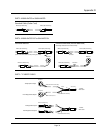
Page 39
Appendix F
Most simply stated, the Compellor will accept an audio input, digital or analog, level it out
and add some compression making it more consistent in average level. The resulting aver-
age output level will target around 0VU. That means –20dBFS in the digital audio world and
+4dBu (or –10dBV depending in the level reference settings) in the analog world. The digital
output will have peaks that may rise up to 0dBFS but will probably not consistently rise above
–8dBFS. That is because audio’s typical crest factor is 10 to 14 dB.
If the Compellor’s limiter is switched in, it will stop peaks at the –6dBFS level for digital audio,
or 14dB above the 0VU reference for analog signals.
If the digital audio input was previously held consistent on a dBFS meter, as if a peak limiter
had been used, it may not look as peak-consistent at the Compellor output. That is because
the Compellor acts to correct the average levels at the expense of letting the peaks fly where
they may. This should not deter you because you’re actually getting what you wanted. If you
want to also see solidly consistent peaks after the Compellor’s processing, then you can add
an Aphex Dominator multiband peak limiter. It will flawlessly bring the peaks to consistent
levels without affecting the average level first established by the Compellor. The Compellor-
Dominator pair is the best audio packaging system there is for effectiveness and sonic trans-
parency.
Handling Codecs & Digital STL’s (Studio-Transmitter Links)
The Ideal Audio Package
Digital audio that is processed by a Compellor is packaged ideally. It has a consistent level
residing around –20dBFS and safe peaks for any digital medium, including bit reduction
codecs.
Analog/Digital Level Discrepancy
Many digital STL’s and codecs have both analog and digital audio inputs. You should be
aware that there can be a level error when switching between them. That is because, while
the Compellor operates at the SMPTE standard level of –20dBFS average, the STL or codec’s
analog input reference may be different. For example, an STL’s analog input reference may
be stated as +4dBu. If the STL coder operates with SMPTE standards, it will convert that level
to –20dBFS digital like the Compellor. In that case, switching between the Compellor’s analog
output and digital output will result in the same digital audio level through the coder. However,
some coders have been calibrated higher than the SMPTE standard. A +4dBu analog input
may translate to higher than –20dBFS, perhaps as high as –12dBFS digital. This is presum-
ably for the purpose of maintaining a better SNR through the codec but at the expense of
all important digital headroom. When switching between the Compellor’s analog and digital
Figure F-2, Typical Codec Applications
Coder
ADC
AES/EBU INPUT
ANALOG INPUT
AES/EBU OUTPUT
ANALOG OUTPUT
DSP
TX
Microwave STL
ISDN LINK
RX
Decoder
DAC
DSP


















